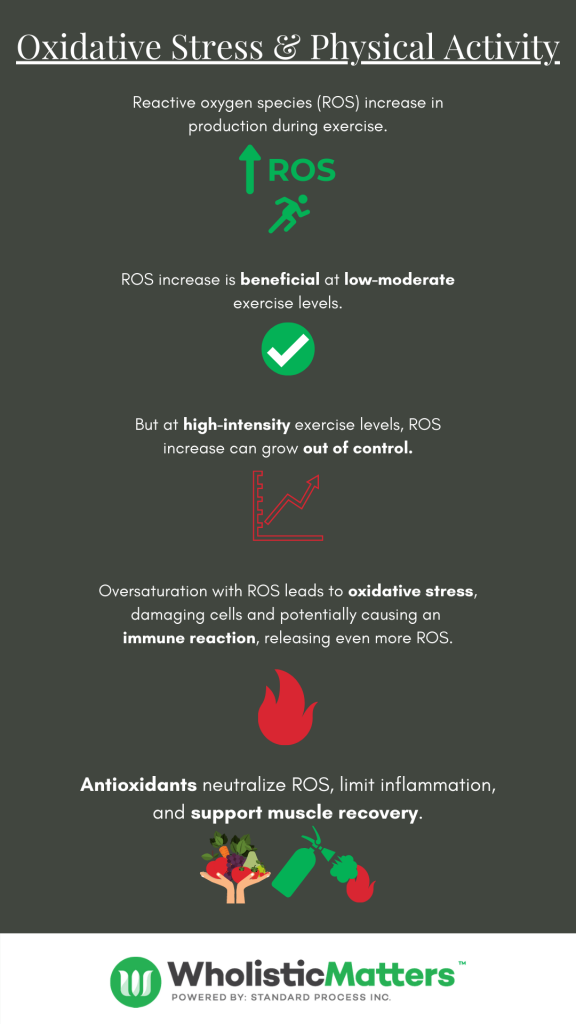Exercise and heavy training in athletes can increase the production of reactive oxygen species (ROS). Antioxidants work to neutralize ROS, keep levels within a healthy range, and minimize the risk of oxidative stress on the body. Exercise plays an important role in this balance, and understanding how to optimally maintain this balance can be essential for performance outcomes.
 Oxidative Stress and Physical Activity
Oxidative Stress and Physical Activity
ROS are important signaling molecules produced in physiological processes such as energy metabolism and immune responses. A balance between ROS production and antioxidant availability is important in keeping the body healthy and functioning optimally during physical activity.
During exercise, energy metabolism turnover increases, along with an increase in ROS production. Increases in ROS production signal a variety of adaptive responses, including increased endogenous antioxidant production, mitochondrial biogenesis, and muscle cell growth.1
At low to moderate exercise this reaction is beneficial, increasing adaptive mechanisms and building up the body’s resistance to oxidative stress.1 However, intense physical activity can destabilize this system, leading to an unfavorable amount of ROS production that overwhelms the antioxidant capacity of the body, resulting in oxidative stress.2,3 This increase in oxidative stress leads to oxidative damage of vital cellular components, including nucleic acids, proteins, and lipids. This cellular damage may trigger an immune system reaction, resulting in additional ROS production.4
This cascading series of events results in inflammation and, ultimately, leads to muscle fiber damage, sub-optimal performance, and increased risk for other pathologies to develop.1 This is where exogenous antioxidants can be valuable in maintaining this delicate balance.
Exogenous Antioxidants and Physical Activity
Exogenous (external) antioxidants are consumed through the diet and complement the function of endogenous (internal) antioxidants, which are formed within the body. Exogenous antioxidants play an important role in neutralizing ROS, limiting inflammation, and aiding in muscle recovery. Together, exogenous and endogenous antioxidants protect cells from oxidative damage by neutralizing ROS.
Some dietary antioxidants include:
- Vitamins A, C, and E
- Polyphenols
- Coenzyme Q10
Dietary antioxidants work to quench free radicals themselves, as well as signal upregulation of gene transcription factors to increase production of endogenous antioxidants.
High amounts of antioxidants are found in plants, particularly fruits and vegetables. For athletes with less than optimal dietary intake of fruit and vegetables – and a subsequent inadequate supply of antioxidants – nutritional supplements can be beneficial to neutralize excessive ROS produced during exercise.
Antioxidants for Exercise Performance & Recovery
Because of the connection between antioxidants and ROS balance, antioxidant-rich supplementation has been of interest for promoting athletic performance and mitigating detrimental effects of over-exercising. Antioxidants have been shown to reduce markers of oxidative stress and muscle damage.5,6 However, studies have shown high doses of antioxidant vitamins C and E (one gram per day and higher) can have adverse effects, blunting beneficial adaptations that occur from exercise.7-10 If an individual is looking to build muscle and adapt to training, consuming antioxidants at high doses (specifically vitamins C and E) may not be advantageous, whereas lower doses may be more supportive in recovery.1
Antioxidants from plant-based polyphenols have various biological effects with significant effects on promoting health. They have been shown to trigger mitochondrial biogenesis, potentially having positive impact on athlete performance.11 In a meta-analysis of randomized clinical trials (RCTs) on athletic male subjects, seven days of polyphenol supplementation increased performance by 1.9 percent.11 The studies included in the meta-analysis used individual polyphenols, polyphenol mixes, or whole food-based polyphenol combinations.11 This is important because it shows that whole food-based polyphenols can have positive effects similar to that of individual polyphenol supplementation. Whole food-based antioxidants, delivered in their whole food matrix, are effective and comparable to individual antioxidants. Whole foods contain a variety of different antioxidants in naturally occurring ratios and proportions that may act synergistically with other nutrients for better clinical outcomes.1
Antioxidants and Physical Activity
A diet rich in antioxidants, from food or supplements, is essential to maintain a healthy ROS-antioxidant balance during exercise and to minimize the potential negative effects of oxidative stress on health. For physically active individuals, supplementation with antioxidants from whole foods and/or whole food derived supplements may be advantageous to support performance and recovery following intensive training. Athletes, who are focusing on quick recovery for back-to-back performances, may benefit greatly from increasing antioxidant intake and limiting inflammation that results from strenuous exercise.














